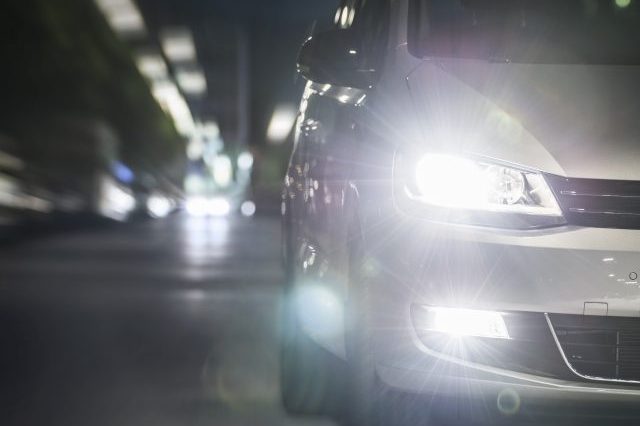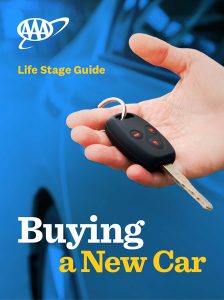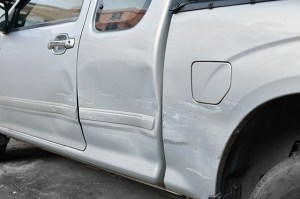Drivers are increasingly complaining about the intense LED headlight glare that comes from newer vehicles, but the issue is not as clear as one might think.
The U.S. is taking baby steps toward smart headlight systems that adjust their beams based on what is in their path and look less harsh to oncoming drivers, but they still could be years away from hitting the roads.
Why Are Headlights So Bright These Days?
Some experts say several factors are contributing to drivers reporting glare. One is that LED lights are not brighter, but the blueish-white light emitted is more irritating to the human eye. The others relate to the position of the headlights, the height of newer vehicles and older drivers.
AAA has published numerous studies about headlights and related issues such as glare and did not find a problem, according to Greg Brannon, director of automotive engineering and industry relations for AAA Inc. “LEDs put more light on roads where people need it,” he said. “There is no evidence that LED lights are a hazard.”
Drivers Disagree
Still, drivers are reporting discomfort and being blinded by oncoming cars with LED headlights and some are calling for them to be banned.
“There is a problem,” acknowledged Dr. John Bullough, director of the Light and Health Research Center at the Icahn School of Medicine at Mount Sinai in New York City. “There are some issues (with headlights) people are experiencing more than they did 10-to-20 years ago, and they are making more people complain. But the basic regulations for headlights and how they produce light in certain directions have been the same for several decades. Technology has changed.”
Over the past 10 years, automakers transitioned to LEDs and high-intensity discharge (HID) headlights from halogen headlights, which produce soft yellow light, which is easier on the eyes. On the plus side, LED bulbs last longer and an LED array has many small bulbs, which can be shifted in different directions to shape the beam. The white light also makes it easier to spot road markings and more closely resembles daylight.
But there are drawbacks. “They tend to make glare more noticeable and uncomfortable,” according to Bullough.

Calls to Regulate LED Headlights
Groups such as the Soft Lights Foundation argue that the use of LED and HID headlights “has become a source of dangerous, blinding glare,” and has an online petition asking Congress and federal agencies to regulate LEDs. More than 50,000 people have signed the petition so far.
Other factors are contributing to people experiencing headlight glare, according to Bullough. Many vehicles are higher now, so lights on SUVs and trucks shine directly into the eyes of sedan drivers, he said. “Passenger cars get a brighter splash of light.”
Also, headlights are often misaligned, and drivers don’t realize it. “Consistently, over a few decades, a lot of cars have poorly misdirected headlights,” said Bullough. “If they are too high, the beam hits (oncoming drivers) in the eyes. If they are too low, drivers can’t see much past their car.” Not all states require headlight alignment to be assessed, he added.
The aging of the U.S. population also plays a role, Brannon maintained. There were almost 48 million licensed drivers ages 65 and older in 2020, according to the latest research from the Centers for Disease Control and Prevention. That is a 68% increase over 20 years ago. “New technology looks different coming toward older drivers, when they are used to seeing a soft yellow glow,” he said. “The LED and HID lights draw drivers’ attention, and then they have a problem with a glare.”
People’s ability to see in the dark decreases every year after age 40, Brannon added, and drivers are less able to recover from glare. To cope with glare, Brannon recommended drivers modify their gaze and look at the road, not the oncoming headlights.
Smarter Headlights Are on the Way
If anything, headlights on U.S. cars should be brighter, Brannon said. The U.S. has a much lower maximum output for high beams than most countries and standards have not changed in decades. AAA research shows that 64% of American drivers do not extensively use their high beams, often out of concern for other drivers. But driving with low beams all the time can be a safety hazard. “If you are driving with low beams over 35 mph and encounter something in the road, you can’t stop in time,” according to Bullough.
Changes are coming, although slowly. More new cars in the U.S. have automatic high/low beam switching systems, which allow drivers to use their high beams all the time, because the headlights switch to low beams if they detect an oncoming vehicle.
Even more advanced technology is available, but not in the U.S., and although high-tech headlights have been approved here, it still could be years before drivers actually see them. Since 2013, Europe and most of the world have been using adaptive driving beam (ADB) headlights, which produce more light and automatically change the direction of the beam to reduce glare for oncoming drivers or pedestrians while not losing forward illumination.
Despite urging from multiple organizations, including AAA, the type of ADBs used by most of the world have not been approved for use in the U.S.
Crafting New ADBs
In 2022, the National Highway Traffic Safety Administration (NHTSA) approved ADB headlighting systems similar to what is used in other countries, but with different criteria for performance, according to Bullough.
The U.S. Department of Transportation drew up glare-proof specifications for ADB headlights, but more testing and information are required. Vehicle manufacturers are waiting for detailed specifications before starting to build and install these systems, to avoid misinterpretations and recalls, according to Bullough.
Because these headlights will be brighter, the changes also will require some adjustments by drivers, but the headlights are overdue, said Brannon. “Modern headlight systems put light where you need it,” he said. “Over time, people will become more accustomed to it.”
Need headlight maintenance? Visit your nearest AAA Approved Auto Repair Facility. Members can save up to $75 per visit – that pays for your membership! Search for AAR facilities.
How do you feel about headlight glare? Share your thoughts in the comments below.
218 Thoughts on “What’s the Story With Headlight Glare?”
Leave A Comment
Comments are subject to moderation and may or may not be published at the editor’s discretion. Only comments that are relevant to the article and add value to the Your AAA community will be considered. Comments may be edited for clarity and length.












Meanwhile
All we have / should do
Is just switch to low beam
To incoming traffic…
That’s call
Courtesy
Educated person
Good driver
✏️📁🙏🙏🙏🙏
Seriously, lets post the MSCP of the LED headlamps AND the same data for the proper matching Incandescent in the same headlamp housing.
My eyes are so irritated by LED vehicle light and streetlight glare that I have to shield my eyes at stoplights and when oncoming traffic approaches. In spite of increased risk, when highway driving at night, in addition to adjusting the inside rear view mirror, I have to adjust the driver’s outside rear view mirror to a severe angle in order to eliminate glare of cars behind me. LED lights on the road are a serious problem for me!
Not only are the headlights blinding and extremely dangerous to all on the road, but the cars now have many Lights on the front not just a headlight. If they are suppose to “lighten/brighten up” the road, then they should be pointed down more than they are up. You should not have to take your eyes off the road or to the side as that is just as dangerous. It is not just one car but when there are several cars in a row, you actually are blinded for enough time to have an accident. This is just plain crazy that they don’t go back to the other lights, it’s definitely a safety issue for all!!!
Also, many people have tinted windows now that make it even harder for them to see at night so they just leave their high beams on blinding everyone else. Very selfish and dangerous!
Young or older the problem is experienced the same way. LED headlights are blinding and dangerous. If someone crosses in front of you as a car is heading towards you you can’t see them. I’d like to know the number of accidents blamed on LEDs headlights
If LED lights irritate the eye, then why is government pushing LED lights in homes, e.g., desk lights, kitchen overhead lights, and lights throughout the house?????? The gummint says that LEDs save energy, while in the meantime affecting your eyesight. What’s more important?????
I disagree. They purposely have their high beams on because when I put mine on at them they turn theirs off. And if they are behind me I flip my rear view mirror up so they get blinded too. Fight fire with fire.
Blinding. Glare. You can describe the light situation with different terms and reasonings, but there is no doubt the intensity of oncoming headlights from other vehicles has increased dramatically. I have experienced this when driving at night and I have heard many anecdotes from acquaintances that confirm this is occurring at night. It is without meaning to parse words or criticize others about their concerns and descriptions regarding this obvious situation. It seems people are not intelligent or considerate enough to adjust their lights went they meet oncoming traffic. This is an issue that should be addressed regardless of the exact source of the problem.
I believe the main problem is not headlight brightness as such, but the fact that many vehicles have their lights mounted too high and their beam shapes not properly controlled. With proper engineering, it should be possible to ensure that the brightness of any headlight low beam at the height of the driver of an oncoming small sedan on a level road is not blinding. If that requires mounting the lights on trucks and SUVs so low that they look silly, so be it! High beams have always been potentially blinding, which is why they can be turned off; automatic beam lowering should be required on all new cars.
One other reason that is absolutely intolerable for some older drivers with glare issues is that those who have cataracts not deemed ripe enough for surgery see large shards of light forming a 360 degree ring around these beams of light. This is an accident waiting to happen.
I’ve been driving for almost sixty years. The head lights ARE brighter, no question, and they constitute a hazard. This is a safety issue. The regulatory agencies that are supposed to handle this problem aren’t doing their jobs.
I would also like to replace my rear-view mirror with the ‘old fashioned’ one that I could manually adjust to reduce the glare from behind.
I keep thinking that a ‘glare reducer’ for the lower portion of my windshield would work – I am researching polarized plastic sheets to place In front of the lower third of my windshield. I drive a lot at night and find myself blocking the glare with my hand which totally blocks my view as well – not safe.
I’m only 23 and work night shifts and can PROMISE you this is not a “senior issue.” You can immediately distinguish a car with the blinding LED’s from every other car on the road and as the years pass they become more common, with the majority of new trucks, jeeps, and SUVs having misaligned headlights. This is purely an issue of automakers not properly inspecting/being held to proper standards and it’s clear your “director of automotive engineering and industry relations” isn’t approaching this in good faith.
The new headlights are way too bright and way too high and should be on a more down angle rather than straight ahead. Especially with seniors, that is a big problem. There is not one person I know who has not complained about them. The experts can say what they want but I think they csould listen to the people driving and try to solve the problem.
As a senior citizen who has always suffered with an astigmatism, when driving at night I turn my sight to the curb line at the right of the road in order to avoid the glare of oncoming headlights. It works for me, but I agree …..with all the safety features now in newer cars, this is a no brainer to install self correcting headlights.
This irritates the …. out of me.
Why do the US authorities refuse to accept obviously good products and practices from elsewhere and instead dither for decades making rules and regulations.
Why can’t we have adaptive LED lights, yellow rear indicators (instead of red) and headlight adjustment as a routine, and mandatory, part of every road worthyness inspection.
Yes, These new headlights are bothering me during day and specially at night from oncoming and behind vehicle. The Federal government should act faster to resolve this issue! Old is gold!
The only thing you can do is put at least. 20% tint on rear windows. To stop blinding from rear
And wear night vision. Glasses . To stop frontal. Blinding Glare
Auto co.s should be forced to use glass Lenses and get rid of the dopey plastic.